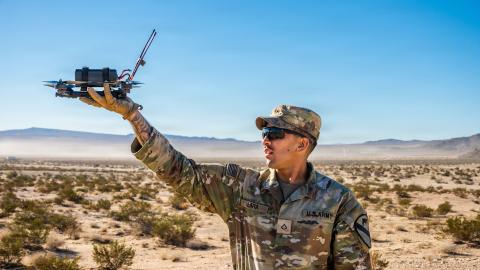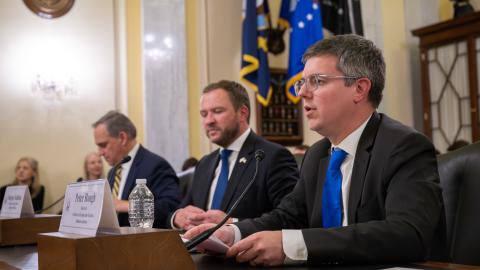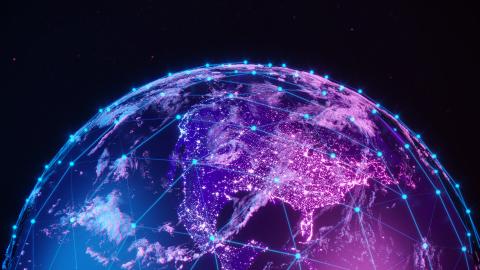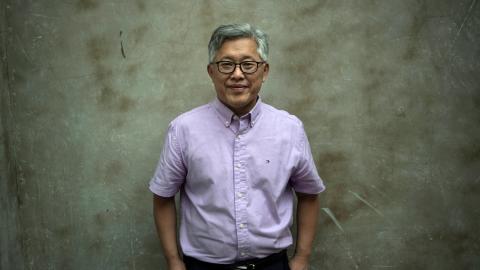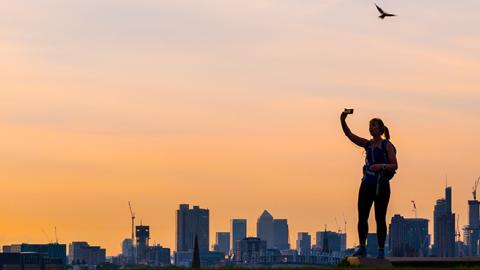Walter Benjamin, writing in 1934 about the new medium of moving film and the role of the audience, captured a dynamic that applies to today’s social media users:
“In the end, [the actor] is confronting the masses. It is they who will control him. Those who are not visible, not present while he executes his performance, are precisely the ones who will control it. This invisibility heightens the authority of their control.”
Benjamin wrote those words as a warning about how mass media could be harnessed by the fascist powers ascending at the time. Yet today’s social media user has more in common with Benjamin’s actor than the person she was in the pre-digital era. Whether on Facebook or Instagram, we are all actors performing for an invisible audience, our actions influenced by an amorphous collective that is as likely to include one’s boss as one’s dog walker.
The power of this invisible influence struck me on a recent visit to the Hirshhorn Gallery in Washington, DC. I was standing in line to enter an “infinity mirror room” within Yayoi Kusama’s blockbuster retrospective exhibit. The trademark creation in Kusama’s 75 years of artistic output, the cube-shaped infinity rooms immerse visitors in a range of ethereal dreamscapes. Despite filling just 130 square feet, the mirror-lined interiors create a recursive effect that surrounds the visitor in an ever-expanding starry galaxy or field of glowing pumpkins.
When I reached the front of the line to enter an infinity room, a staff member armed with a stopwatch paired me with two teen girls for our foray into “The Souls of Millions of Light Years Away.” The two girls looked crestfallen. They had expected to have the room to themselves, and now their selfie opportunity would be photo-bombed by a stranger in a dreadfully pragmatic skirt suit.
The staff member shut the door, and our allotted 30 seconds in the room began. My two new friends immediately began posing and taking selfies together. I tried to shrink my presence and avoid ruining their photos—a difficult feat in a room of mirrors—as the thirty seconds proved as limitless as the horizon. While I had expected large crowds at the exhibit, I wasn’t expecting large entitled crowds. These girls had arrived with a single-minded sense of purpose, taking selfies as one might pick up a gallon of milk at the supermarket.
Kusama’s artwork focuses on the notion of “self-obliteration,” yet self-aggrandizement would become the defining narrative of the exhibit. Countless visitors, mobile phones in hand, have repurposed Kusama’s magnum opus into window dressing for their personal brands. The ubiquity of this new behavior has inspired numerous guides on how to take the “perfect infinity room selfie,” and even a cautionary article in Insurance Journal, warning museum insurers about the spike in damaged art due to selfie-takers. During the exhibit’s run at the Hirshhorn, social media accounts from DC to New York were flooded with Kusama selfies. The trend will continue as the exhibit begins a five-city tour.
A selfie can be more than just a selfie. In the gallery setting, selfie-taking subverts a pact that has existed between museums and visitors since the Enlightenment Era. Museums offer a transformational experience and communion with creative genius in exchange for the focused attention of its visitors. But when we walk through a gallery today, we are accompanied by our invisible audience and the lure of self-presentation in the digital era. The average museum visitor spends seven seconds in front of an artwork—how you choose to spend each second counts.
The first public museums were created to embody nationalist ambitions and the enlightenment values of reason, progress, and universal rights. The British Museum was founded in 1753 to house the collection of curiosities amassed by naturalist Sir Hans Sloane, some 71,000 artworks, specimens, and antiquities. The vast collections stood as a testament to man’s genius, nature’s diversity, and the acquisitional might of the British Empire. At the time, most similar collections were privately held and required a letter of introduction for admission. The British Museum, on the other hand, welcomed “studious and curious Persons” of all ages and social classes.
Across the English Channel, the young revolutionary government of the French Republic followed suit. Months after executing Louis XVI in 1793, the gates of the Louvre palace were thrown open. Visitors were treated to the vast collections of art formerly owned by the church and royal family, and, within a few decades, the treasures that Napoleon Bonaparte plucked from his conquered nations. The Louvre seemed to reify the particularly French assertion that true authority was no longer founded in doctrine mediated by the church, but in objectively verifiable truths cared for by l’état.
These early museums, with their treasures preserved in massive cathedral-like spaces, stood as the Enlightenment’s secular rejoinder to the religious reliquary. Germain Bazin, a curator at the Louvre in the 19th century, observed that the visitor enters a museum hoping to discover “those momentary cultural epiphanies” that give him “the illusion of knowing intuitively his essence and his strengths.” While the collections catered to the prevailing trends of intellectual curiosity and civic pride, the expectations that typically accompany sacred rituals were transferred to these secular spaces. Museums still relied on an inherently religious model of experience to convey the significance of its collection. In exchange for a visitor’s complete attention and renunciation of outside concerns, museums promised a deeply transformative experience.
In her classic essay “The Art Museum as Ritual,” Carol Duncan characterizes the early museums as resembling medieval cathedrals. A hushed atmosphere, with few windows and reminders of the world beyond, insulates the visitor in a heightened space created by the artist and the curator. Citizens entered the public museums as equals, given a respite from the pressures and stratification of everyday life, just as a church might welcome all worshippers. Similar to a pilgrim following the path of a relic-studded ambulatory, a gallery visitor would follow a prescribed path that encouraged moments of rest and contemplation.
Goethe, visiting the Dresden Gallery in 1768, describes his visit in terms that could be used to describe the Met or National Gallery of Art today: “…the well-waxed parquetry, the profound silence that reigned, created a solemn and unique impression, akin to the emotion experienced upon entering a House of God, and it deepened as one looked at the ornaments on exhibition, which, as much as the temple that housed them, were objects of adoration in that place consecrated to the holy ends of art.”
Nearly 250 years later, Goethe’s “holy ends of art” remain the primary justification for why we while away our afternoons at museums. While “artistic genius” may be defined differently today—compare Rembrandt’s The Night Watch to Maurizio Cattelan’s golden toilet at the Guggenheim—today’s art institutions still claim to serve the same function in society. We uphold the Enlightenment Era notion that art offers society a reservoir of profound meaning and a conduit to self-knowledge.
Deeply transformative experiences do not come for free, however. They require the abdication of self, a notion deeply embedded in most religious texts and rituals. Christianity’s view of spiritual salvation hinges on the sacrifice of one’s body, heart, and soul to God. Buddhists believe that we’ll all be much happier if we release our ego and its attendant fears and desires. “With ascetism, wisdom bears fruit,” said Ali bin Abi Talib, known as Shi‘i Islam’s first imam. Millennia of tradition assert the same thing: if we’re going to receive the profound lessons of our mystic guides, we must first shed our cloaks of conceit and vanity.
Mobile technology encourages us to forego the Enlightenment Era experience and its accompanying promise of profound self-knowledge. With the invisible audience of social media always lurking in our mobile phones, we are tempted to permanently affix a scrim of personal narrative over the artwork we see and experience.
Do art selfies correlate with lower levels of engagement with the artwork? I examined a sample of public Instagram posts taken by visitors to the Hirshhorn, comparing 100 photos from the viral Kusama exhibit to 100 photos from the concurrent Hirshhorn Masterworks exhibit. How would Kusama stack up against the best works by Joan Miro, Edward Hopper, Gerard Richter, and Constantin Brancusi?
At the Kusama exhibit, I discovered that self-representation was the overwhelming motivation behind Instagram posts, at the expense of any deeper exploration of Kusama’s artwork. A full 70 percent of posts tagged with #InfiniteKusama were art selfies. Only one-quarter of Kusama art selfies included an observation about the exhibit. The other three-quarters of Kusama art selfies featured the kind of self-referential Insta-speak that requires minimal reflection, such as #currentmood or #vibes. Visitors to the Masterworks exhibit, on the other hand, were 14 times less likely to post art selfies than Kusama Instagrammers. These visitors only posted selfies in 5 percent of their Instagram posts, and were twice as likely to supplement their selfies with observations about the artwork.
Selfies present a catch-22 of mutually conflicting intentions. Increasingly, we take selfies to signify that we’re in the presence of something extraordinary. A Paul McCartney concert is more likely to warrant a selfie than an afternoon spent scrubbing the bathtub. We are motivated by a desire to let the invisible audiences of social media know that we are affiliated with an exalted object, person, or place. Yet in the process of taking a selfie, we degrade the object of our respect by subordinating it to our self-promotion. We push the artwork behind us in a literal act of giving it the cold shoulder. Upon the altar of an artist’s thoughtful creativity, we offer our own banality. What requires less intellectual engagement, less genuine consideration, than smiling and looking into a camera?
By taking selfies and turning art into accessory, we’re not only robbing ourselves on a personal level—we are shaping the collective experience and depriving our friends as well.
Not long ago, our first impression of a new exhibit would have been influenced by words rather than images. A carefully written preview in The New Yorker or a friend’s comments would be all the advanced guidance needed before going to an art gallery. Seduction is predicated on mystery, and a good gallery preview (or word from a friend) might sketch the contours of the exhibit while leaving enough unrevealed to tantalize the imagination.
The joy of personal discovery is the mechanism that imbues art with power. Anatoli Mikhailov, the former rector of a liberal arts university shut down by Alexander Lukashenko, describes what we gain from being present with art. “We can then experience the wonder and surprise that accompany the immediate experience of an artwork, thereby enlarging our horizons and contributing to our development as human beings.1
Today, when an art exhibit goes viral and sparks a Mass Selfie Event, we have little choice but to absorb image after image displayed in our social media feeds. This advance guard of photos leeches the “wonder and surprise” we might feel, as every corner of an exhibit is revealed and over-exposed. Within two weeks of the Kusama exhibit’s three-month run at the Hirshhorn, the rote repetition of selfies had already transformed the exhibit into an “insert-your-face-here” cliché. Before we take one step into the gallery, we have already seen what we have come to discover.
Blockbuster artistic events expose the tension between a collective experience shared on social media and the vivid impact of individual discovery. In other contexts, however, it seems we have found a solution. Popular television shows, like Game of Thrones or House of Cards have been accompanied by new social conventions that seek to protect the watching experience for the collective. By providing “spoiler alerts” (a.k.a., advance warning) before revealing juicy details, we acknowledge that the viewing experience relies on the power of those unanticipated moments of storytelling.
On social media, art exhibitions should be handled with the same care as an eagerly awaited episode of television. To relish each art-going experience, we have to protect those moments of joyful discovery and respect the creative progression laid out by artist and curator. How differently would we watch the series finale of The Sopranos, if we knew its abrupt ending even before Tony stepped foot in the diner? Could we still lose ourselves in the episode’s slowly building tension if we knew that the repeated dinging of the diner’s doorbell and crescendo in Journey’s “Don’t Stop Believin’” marked the swan song of a mafia don?
On the question of “to post, or not to post,” social media applies opposing pressures simultaneously. As with Game of Thrones or The Sopranos, we are capable of developing social conventions that reward restraint over display, to protect the collective viewing experience. What influences our decision to forego these social pressures, and treat gallery-going not as a protected experience, but as the virtual equivalent of a conspicuous luxury item?
Evolutionary psychology reveals the motivations that tempt us to take art selfies and the social pressures introduced by social media. Anthropologist Aimee Plourde, in examining the notion of prestige and its function in society, notes that the act of signaling prestige allows a person to cement or advance her status in a social group. When our friends engage in prestigious activities, it signals that we should “pay particular attention to the details of their behaviors and opinions, to maintain proximity to them, and to desire their friendship.”
Art selfies are the latest tech-enabled manifestation of our search for social status, which according to Plourde, can be attributed to three societal factors. The pressure for prestige is intensified by an enlarging group size; an increase in the complexity of skills demonstrated in the social group; and technological innovation, which advantages those who master the new system. Courtesy of the digital age, we are presented with these three pressures in ever-increasing levels. Walter Benjamin’s “invisible audience,” with its ambiguous membership that we can only conceptualize but never fully know, is now the backdrop to these additional social pressures. Art gets caught up in this never-ending race, which, thanks to the internet’s limitless horizons, takes place in its own infinity room.
Cultural institutions should not rest easy with the selfie trend, even though many do. Public art museums see mobile phone technology as a route to higher levels of visitor engagement that will justify grant dollars and corporate sponsorships like never before.
At the blue-chip Saatchi Gallery in London, a current exhibit reflects the struggle of art’s legitimizing institutions to find purpose in the narcissistic impulse. In an exhibit titled “From Selfie to Self-Expression,” snaps of Kim Kardashian keep company with Gustave Courbet and Rembrandt. Nigel Hurst, the gallery’s CEO, described the exhibit in the same manner one might comment on the questionable cooking of a loved one: “The selfie represents the epitome of contemporary culture’s transition into a highly digitized and technologically advanced age.” It is more of an observation than an exaltation, and damns the exhibit with faint praise.
For better and for worse, by embracing the habits created by technology, galleries can reach new funders. Saatchi’s selfie exhibit was sponsored by Huawei, a Chinese technology producer with an alleged pesky habit of installing spyware in the hardware it sells western companies. Huawei’s sponsorship also coincided with the debut of their new camera phone, further complementing the “zero boundaries” theme.
Yet social media and museums do not have to be an unholy alliance, and a series of recent social media experiments are reframing attentiveness and the museum-visitor pact in ways not possible during the Enlightenment Era.
The minds behind the Instagram account @Artwatchers_United are exploring new contours of the artwork-visitor relationship by inverting the art selfie dynamic. Rather than depicting art as a glamorizing accessory, visitors are accessories to the artwork. The account’s “curators” choose photos submitted by their followers, either candid or posed, of gallery visitors locked in a visual and mental interplay with a work of art. A visitor’s gestures, clothing, and expressions all contribute to a Fred-and-Ginger level of human-artwork simpatico, the two locked together in a heightened realm beyond the “invisible controlling masses.” The overall effect is a love note to attentiveness and respect for the creative process.
Some cultural institutions are drifting toward adopting “personal identities” on social media, just as an individual presents a carefully curated account of her life on Instagram. Through the growing trend of #MuseumInstaSwaps, museums are acknowledging the notion that their social media accounts represent their distinct identities, reflecting the interests, priorities, and history of their museum and staff. During an Instaswap, the social media staff of two museums swap the collections that they represent and share online.
Russell Dornan, a social media manager in London who initiated the first Instaswap, describes the responsibility he feels: “Our own interests and skills affect how we talk about the museum activities, the aspects we choose to focus on and the way we decide to interrogate or interpret them.” In one instance, the social media staff of the Cooper Hewitt Museum of Design took over the Intrepid Sea, Air & Space Museum’s Instagram account, and highlighted the beauty and functionality of a wirecutter from the Vietnam War. MoMA’s social media staff wandered the halls of the American Museum of Natural History, choosing to recognize the masterful work of its diorama artists, who painted natural habitats so expressive they lend remarkable vitality to an eighty-year-old taxidermied bear.
For the museums involved in the Instaswaps, and for the gallery-goers chronicled on @Artwatchers_United, the key to success is the same. Self-representation online is anchored in hyper-attentiveness, and a self-awareness of who they are and what their relationship to the art (or museum object) signifies. Acts of curation, on an individual or institutional scale, reflect deliberate choices to enhance certain qualities and omit others, a form of manipulation that can achieve thoughtful ends or obscure them.
As for art-selfie takers eager to be seen, it’s worth noting that you’re being watched in more ways than you think. Artists, those chroniclers of the human condition, have also begun to take notice of the art selfie phenomenon. At this year’s Frieze Art Fair in New York, I wandered the white-walled booths representing over 200 international galleries, observing how attendees interacted with the artwork. Anything that was reflective, brightly-colored, or high contrast became a target for selfies.
I spotted street photographer Daniel Arnold near an artwork resembling a large concave mirror, impassively blending in with other gallery-goers. A member of the “invisible audience” made real. I recognized Arnold from his Instagram account, where his photos capture two types of humans: those so genuine they can’t help but be themselves; and those so wrapped in pretense they seek to become anyone but themselves. He spends most days wading through the morass of Midtown, capturing a world that’s a bit inelegant, disjointed, poignant, andcaptivating. The popularity of his account proves that many people would gladly take his version of normalcy’s strange beauty over the calculated artfulness governing most of Instagram.
Arnold also has an unerring eye for human behavior, capturing unguarded moments of pain, joy, or conceit. Standing next to him and his mirrored lure, I asked what he was doing at Frieze. With a wry smile and camera in hand, he responded: “I’m waiting for people to behave badly.”
